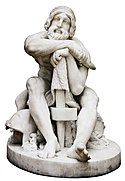Tor's Fight with the Giants
In Mårten Eskil Winge’s interpretation, Thor is strong, blond, resolute and fearless. The painting was extremely well received when it was shown for the first time at Nationalmuseum in 1872, a time when Norse mythology and the gods were enjoying great popularity. Winge was one of many Scandinavian artists who painted the Æsir gods in the 1870s. And their paintings and sculptures still influence our ideas about Vikings and the Æsir gods to this day.
Winge’s original audience interpreted the painting as a general depiction of good battling evil. In modern times, Thor’s battle with the giants has been perceived as an expression of Nationalist or Fascist ideals. The blond-haired Thor has been seen as a defender of the Nordic ideal that is threatened by the dark-haired giants. The swastika on Thor’s belt of power has no doubt helped to make the painting popular among various right-wing extremist groups. For Winge and his contemporaries, the swastika was an ancient decorative symbol for the sun, appearing in architectural decoration and in various logos.Autor zemřel v roce 1896, takže toto dílo je volné také v zemích, jejichž právní řád chrání majetková autorská práva po dobu života autora a 100 let po jeho smrti.
Relevantní obrázky
Relevantní články
ÁsovéÁsové, staroseversky Æsir, jsou skupinou bohů v severské mytologii sídlící ve světě Ásgardu. Jedná se o válečnická a magická božstva známá pro svou znalost run a kouzelných zpěvů jako galdra-smidir („kouzlotepci“). Druhou skupinou božstev, spojenou především s plodností a bohatstvím, jsou Vanové, kteří kdysi s Ásy vedli válku, ale posléze se smířili a tři z Vanů: Njörd, Frey a Freya se usídlili v Ásgardu a jsou počítáni mezi Ásy. .. pokračovat ve čtení
ThórThór neboli Thunor, v mladších, především německých zdrojích, zmiňovaný pod jménem Donar nebo ještě archaičtěji Thunraz je v germánské a severské mytologii bůh hromu, deště, nebe a plodnosti země. Je strážcem a vykonavatelem spravedlnosti. Ochraňuje kováře, mořeplavce, rybáře a rolníky. Nejvíce informací o něm pochází z pozdních islandských pramenů a mnohé z nich se nemusejí týkat ostatních Germánů a starších období. Hned po Ódinovi, který je jeho otcem, je druhým nejdůležitějším bohem. Jeho matkou je Fjörgyn, bohyně země. Thórovou ženou je Sif, se kterou má dceru Trúd. Má také dva syny Módiho a Magniho, avšak s obryní Járnsaxou. V literatuře také označován jako Ásathór či Hromovládce. Thór je klasickým vyobrazením silného a statečného vikinského bojovníka s postavou hromotluka. Oděn v kožešinách s rudě zrzavými vlasy a vousy spletenými do copánků, v ruce obvykle třímá mocné kladivo Mjöllni. .. pokračovat ve čtení









